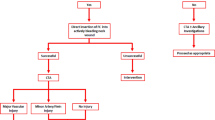Abstract
Background
Foley catheter balloon tamponade (FCBT) for bleeding penetrating neck injuries (PNIs) is effective. This study aims to audit the technique and outcomes of FCBT.
Methods
Adult patients with PNIs requiring FCBT presenting to Groote Schuur Hospital (GSH) within a 22-month study period were prospectively captured on an approved electronic registry. Retrospective analysis included demographics, major injuries, investigations, management and outcomes.
Results
During the study period, 628 patients with PNI were treated at GSH. In 95 patients (15.2%), FCBT was utilised. The majority were men (98%) with an average age of 27.9 years. Most injuries were caused by stab wounds (90.5%). The majority of catheters (81.1%) were inserted prior to arrival at GSH. Computerised tomographic angiography (CTA) was done in 92.6% of patients, while eight patients (8.4%) required catheter-directed angiography. Six were performed for interventional endovascular management. Thirty-four arterial injuries were identified in 29 patients. Ongoing bleeding was noted in three patients, equating to a 97% success rate for haemorrhage control. Thirteen (13.7%) patients required neck exploration. Seventy-two (75.8%) patients without major arterial injury had removal of the catheter at 48–72 h. Two of these bled on catheter removal. A total of 36 complications were documented in 28 patients (29.5%). There was one death due to uncontrolled haemorrhage from the neck wound.
Conclusion
This large series highlights the ease of use of FCBT with high rates of success at haemorrhage control (97%). Venous injuries and minor arterial injuries are definitively managed with this technique.




Similar content being viewed by others
References
Ball CG, Wyrzykowski AD, Nicholas JM et al (2001) A decade's experience with balloon catheter tamponade for the emergency control of hemorrhage. J Trauma 70:330–333
Navsaria P, Thoma M, Nicol A (2006) Foley catheter balloon tamponade for life-threatening haemorrhage in penetrating neck trauma. World J Surg 30:1265–1268. https://doi.org/10.1007/s00268-005-0538-3
Gilroy D, Lakhoo M, Charalambides D et al (1992) Control of life-threatening haemorrhage from the neck: a new indication for balloon tamponade. Injury 23:557–559
Weppner J (2013) Improved mortality from penetrating neck and maxillofacial trauma using Foley catheter balloon tamponade in combat. J Trauma Acute Care Surg 75:220–224
Teixeira F, Menegozzo CA, Netto SD et al (2016) Safety in selective surgical exploration in penetrating neck trauma. World J Emerg Surg 11:1–7
Madsen AS, Bruce JL, Oosthuizen GV et al (2018) The selective non-operative management of penetrating cervical venous trauma is safe and effective. World J Surg 42:3202–3209. https://doi.org/10.1007/s00268-018-4595-9
Navsaria PH (2018) Chapter 4: head and neck hemorrhage: what do I do now? In: Ball CG, Dixon E (eds) Treatment of ongoing bleeding: the art and craft of stopping severe bleeding. Springer, Cham, pp 45–54
McKee JL, Mckee IA, Bouclin MD et al (2019) A randomized controlled trial using iTClamp, direct pressure, and balloon catheter tamponade to control neck haemorrhage in a perfused human cadaver model. J Emerg Med 56:363–370
Author information
Authors and Affiliations
Corresponding author
Ethics declarations
Conflict of interest
None declared.
Ethical approval
HREC REF: 063/2018. Registered Penetrating Neck Injury database: HREC REF: R043/2019.
Informed consent
Informed consent was obtained from all individual participants for whom identifying information is included in this article.
Additional information
Publisher's Note
Springer Nature remains neutral with regard to jurisdictional claims in published maps and institutional affiliations.
Rights and permissions
About this article
Cite this article
Scriba, M., McPherson, D., Edu, S. et al. An Update on Foley Catheter Balloon Tamponade for Penetrating Neck Injuries. World J Surg 44, 2647–2655 (2020). https://doi.org/10.1007/s00268-020-05497-z
Published:
Issue Date:
DOI: https://doi.org/10.1007/s00268-020-05497-z




